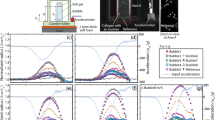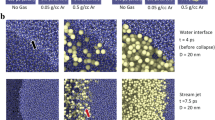Abstract
Cavitation-induced shock wave, as might occur in the head during exposure to blast waves, was investigated as a possible damage mechanism for soft brain tissues. A novel experimental technique was developed to visualize and control single bubble cavitation and its collapse, and the influence of this process on a nearby tissue surrogate was investigated. The experiment utilized a Hopkinson pressure bar system which transmits a simulated blast pressure wave (with over-pressure and under-pressure components) to a fluid-filled test chamber implanted with a seed gas bubble. Growth and collapse of this bubble was recorded during passage of the blast wave with a high speed camera. To investigate the potential for cavitation damage to a tissue surrogate, local changes in strain were measured in hydrogel slices placed in various configurations next to the bubble. The strain measurements were made using digital image correlation (DIC) technique by monitoring the motion of material points on the tissue surrogate. In one configuration, bubble contact dynamics resulted in compression contact (>60 μs) followed by inertially-driven tension (>140 μs). In another configuration, the influence of local shock waves emanating from collapsed bubbles was captured. Large compressive strains (0.25 to 0.5) that were highly localized (0.18 mm2) were measured over a short time period (<24 μs) after bubble collapse. High bubble collapse pressures 29 to 125 times that of peak blast overpressure are predicted to be the source of these large strains. Consistent with theoretical predictions, these cavitation-based strains are far larger than the strains imposed by passage of the simulated blast wave alone. Finally, the value of this experimental platform to investigate the single bubble cavitation-induced damage in a biological tissue is illustrated with an example test on rat brain slices.











Similar content being viewed by others
References
Elder GA, Cristian A (2009) Blast-related mild traumatic brain injury: mechanisms of injury and impact on clinical care. Mt Sinai J Med 76:111–118
Rosenfeld JV, McFarlane AC, Bragge P, Armonda RA, Grimes JB, Ling GS (2013) Blast-related traumatic brain injury. Lancet Neurol 12:882–893
Goeller J, Wardlaw A, Treichler D, O’Bruba J, Weiss G (2012) Investigation of cavitation as a possible damage mechanism in blast-induced traumatic brain injury. J Neurotrauma 29:1970–1981
Goldsmith W (2001) The state of head injury biomechanics: past, present, and future: part 1. Crit Rev Biomed Eng 29:441–600
Brennen CE (1995) Cavitation and bubble dynamics. Oxford University Press, New York
Harvey EN (1945) Decompression sickness and bubble formation in blood and tissues - harvey lecture, october 26, 1944. Bull N Y Acad Med 21:505–536
Apfel RE, Holland CK (1991) The likelihood of cavitation from short-pulse, low-duty cycle diagnostic ultrasound. Ultrasound Med Biol 17:179–185
Blatteau JE, Jean F, Pontier JM, Blanche E, Bompar JM, Meaudre E, Etienne JL (2006) Decompression sickness accident management in remote areas. Use of immediate in-water recompression therapy. Review and elaboration of a new protocol targeted for a mission at clipperton atoll. Ann Fr Anest Reanim 25:874–883
Gateau J, Taccoen N, Tanter M, Aubry JF (2013) Statistics of acoustically induced bubble-nucleation events in in vitro blood: a feasibility study. Ultrasound Med Biol 39:1812–1825
Shima A, Tsujino T, Hoyt JW, Taylor J (1981) A photographic study of cavitation in jet flow - discussion. J Fluids Eng Trans ASME 103:370–372
Vogel A, Lauterborn W, Timm R (1981) Optical and acoustic investigations of the dynamics of laser-produced cavitation bubbles near a solid boundary. J Fluid Mech 206:299–338
Jones IR, Edwards DH (1960) An experimental study of the forces generated by the collapse of transient cavities in water. J Fluid Mech 7:596–603
Tomita Y, Shima A (1986) A. Mechanisms of impulsive pressure generation and damage pit formation by bubble collapse. J Fluid Mech 169:535–564
Wang YC, Huang CH, Lee YC, Tsai HH (2006) Development of a pvdf sensor array for measurement of the impulsive pressure generated by cavitation bubble collapse. Exp Fluids 41:365–373
Benjamin TB and Ellis AT (1966) Collapse of cavitation bubbles and pressures thereby produced against solid boundaries. Philos Trans R Soc Lond A Math Phys Sci 260:221–228
Kornfeld M, Suvorov L (1944) On the destructive action of cavitation. J Appl Phys 15:495–506
Rayleigh (1917) On the pressure developed in a liquid during the collapse of a spherical cavity. Philos Mag 34:94–98
Plesset MS, Chapman RB (1971) Collapse of an initially spherical vapour cavity in neighbourhood of a solid boundary. J Fluid Mech 47:283–290
Moore DF, Jerusalem A, Nyein M, Noels L, Jaffee MS, Radovitzky RA (2009) Computational biology - modeling of primary blast effects on the central nervous system. Neuroimage 47:T10–T20
Nyein MK, Jason AM, Yu L, Pita CM, Joannopoulos JD, Moore DF, Radovitzky RA (2010) In silico investigation of intracranial blast mitigation with relevance to military traumatic brain injury. Proc Natl Acad Sci U S A 107:20703–20708
Shridharani JK, Wood GW, Panzer MB, Capehart BP, Nyein MK, Radovitzky RA, Bass CRD (2012) Porcine head response to blast. Front Neurol 3:70
Kenner VH, Goldsmit W (1973) Impact on a simple physical model of head. J Biomech 6:1–11
Lubock P, Goldsmith W (1980) Experimental cavitation studies in a model head-neck system. J Biomech 13:1041–1047
Gross AG (1958) A new theory on the dynamics of brain concussion and brain injury. J Neurosurg 15:548–561
Moss WC, King MJ, Blackman EG (2009) Skull flexure from blast waves: a mechanism for brain injury with implications for helmet design. Phys Rev Lett 103:2650–2665
Delius M (2002) Twenty years of shock wave research at the institute for surgical research. Eur Surg Res 34:30–36
Ohl CD, Arora M, Ikink R, de Jong N, Versluis M, Delius M, Lohse D (2006) Sonoporation from jetting cavitation bubbles. Biophys J 91:4285–4295
Okie S (2005) Traumatic brain injury in the war zone. N Engl J Med 352:2043–2047
Mayorga MA (1997) The pathology of primary blast overpressure injury. Toxicology 121:17–28
Harrison M (1952) An experimental study of single bubble cavitation noise. J Acoust Soc Am 24:454–454
Sarntinoranont M, Lee SJ, Hong Y, King MA, Subhash G, Kwon J, Moore DF (2012) High-strain-rate brain injury model using submerged acute rat brain tissue slices. J Neurotrauma 29:418–429
Ravichandran G, Subhash G (1994) Critical-appraisal of limiting strain rates for compression testing of ceramics in a split hopkinson pressure bar. J Am Ceram Soc 77:263–267
Subhash G, Ravichandran G (2000) Split Hopkinson pressure bar testing of ceramics. Mech Test Eval ASM Int 8:497–504
Subhash G, Liu Q, Moore DF, Ifju PG, Haile MA (2011) Concentration dependence of tensile behavior in agarose gel using digital image correlation. Exp Mech 51:255–262
Liu QL, Subhash G (2006) Characterization of viscoelastic properties of polymer bar using iterative deconvolution in the time domain. Mech Mater 38:1105–1117
Subhash G, Liu QL, Gao XL (2006) Quasistatic and high strain rate uniaxial compressive response of polymeric structural foams. Int J Impact Eng 32:1113–1126
Lee SJ, Sun J, Flint JJ, Guo S, Xie HK, King MA, Sarntinoranont M (2011) Optically based-indentation technique for acute rat brain tissue slices and thin biomaterials. J Biomed Mater Res Part B 97B:84–95
Van Dommelen JAW, Van der Sande TPJ, Hrapko M, Peters GWM (2010) Mechanical properties of brain tissue by indentation: Interregional variation. J Mech Behav Biomed Mater 3:158–166
Pan B, Xie HM, Guo ZQ, Hua T (2007) Full-field strain measurement using a two-dimensional savitzky-golay digital differentiator in digital image correlation. Opt Eng 46:033601
Pan B, Qian KM, Xie HM, Asundi A (2009) Two-dimensional digital image correlation for in-plane displacement and strain measurement: a review. Meas Sci Technol 20:1–17
Nakase-Richardson R, McNamee S, Howe LL, Massengale J, Peterson M, Barnett SD, Harris O, McCarthy M, Tran J, Scott S, Cifu DX (2013) Descriptive characteristics and rehabilitation outcomes in active duty military personnel and veterans with disorders of consciousness with combat- and noncombat-related brain injury. Arch Phys Med Rehabil 94:1861–1869
Kato K, Fujimura M, Nakagawa A, Saito A, Ohki T, Takayama K, Tominaga T (2007) Pressure-dependent effect of shock waves on rat brain: Induction of neuronal apoptosis mediated by a caspase-dependent pathway. J Neurosurg 106:667–676
Long JB, Bentley TL, Wessner KA, Cerone C, Sweeney S, Bauman RA (2009) Blast overpressure in rats: recreating a battlefield injury in the laboratory. J Neurotrauma 26:827–840
Cullen DK, LaPlaca MC (2006) Neuronal response to high rate shear deformation depends on heterogeneity of the local strain field. J Neurotrauma 23:1304–1319
Cullen DK, Simon CM, LaPlaca MC (2007) Strain rate-dependent induction of reactive astrogliosis and cell death in three-dimensional neuronal-astrocytic co-cultures. Brain Res 1158:103–115
Geddes DM, Cargill RS, LaPlaca MC (2003) Mechanical stretch to neurons results in a strain rate and magnitude-dependent increase in plasma membrane permeability. J Neurotrauma 20:1039–1049
Bain AC, Meaney DF (2000) Tissue-level thresholds for axonal damage in an experimental model of central nervous system white matter injury. J Biomech Eng Trans ASME 122(6):615–622
Morrison B, Cater HL, Benham CD, Sundstrom LE (2006) An in vitro model of traumatic brain injury utilising two-dimensional stretch of organotypic hippocampal slice cultures. J Neurosci Methods 150(2):192–201
Morrison B, Meaney DF, Margulies SS, McIntosh TK (2000) Dynamic mechanical stretch of organotypic brain slice cultures induces differential genomic expression: relationship to mechanical parameters. J Biomech Eng Trans ASME 122(3):224–230
Kurosawa Y, Kato K, Saito S, Kubo M, Uzuka T, Fujii Y and Takahashi H (2009) Basic study of brain injury mechanism caused by cavitation. Conference proceedings: Annual International Conference of the IEEE Engineering in Medicine and Biology Society. IEEE Eng Med Biol Soc Conf 2009:7224–7227
Acknowledgments
This research was funded by the Army Research Office award number W911NF-10-1-0276.
Author information
Authors and Affiliations
Corresponding author
Rights and permissions
About this article
Cite this article
Hong, Y., Sarntinoranont, M., Subhash, G. et al. Localized Tissue Surrogate Deformation due to Controlled Single Bubble Cavitation. Exp Mech 56, 97–109 (2016). https://doi.org/10.1007/s11340-015-0024-2
Received:
Accepted:
Published:
Issue Date:
DOI: https://doi.org/10.1007/s11340-015-0024-2




